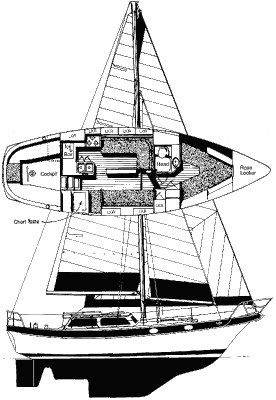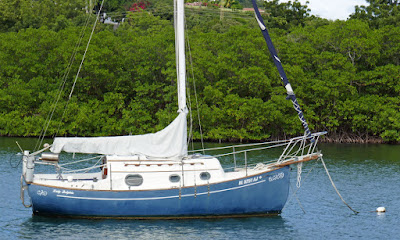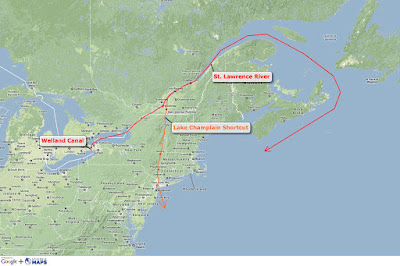"It is impossible, in this world, to achieve an ideal; and if you do not believe this, I recommend you to take a picture of your perfect ship out of your mind's eye and try to copy it exactly in metal and canvas and wood."
- Weston Martyr, British yachtsmen and partial influence for the creation of the Fastnet race
Following on the theme of choosing a cruising sailboat as an exercise in compromise, I thought I'd turn a bit "math geek" and examine some of the numbers and formulas that attempt to quantify sailboat design.
Now before you start sending comments and emails telling me that numbers don't tell the whole story and such, let me say that this post and a few others I've made about sailboat design are merely part of my own education and exploration of my sailboat and the many others out there that could one day be our next cruising sailboat.
So, with the disclaimer now out of the way, let's begin.
Have you ever thought about the motion of a sailboat in varying sea conditions? Does she have a slow and easy movement or is she skiddish and unsettled? Does she hobbyhorse (pitch fore and aft) enough to make you loose your lunch, or is she steady and balanced through the swells? Do you notice major differences in the motion of one sailboat to the next?
Quantifying the motion of a sailboat in a seaway and placing it somewhere along a comfort continuum is sort of how I see Ted Brewer's "Comfort Ratio" (CR) being used to evaluate sailboat designs. But even better than my definition are Ted's own words on the matter:
"This is a ratio that I dreamed up, tongue-in-cheek, as a measure of motion comfort but it has been widely accepted and, indeed, does provide a reasonable comparison between yachts of similar type. It is based on the fact that the faster the motion the more upsetting it is to the average person. Given a wave of X height, the speed of the upward motion depends on the displacement of the yacht and the amount of waterline area that is acted upon. Greater displacement, or lesser WL area, gives a slower motion and more comfort for any given sea state.
Beam does enter into it as wider beam increases stability, increases WL area, and generates a faster reaction. The formula takes into account the displacement, the WL area, and adds a beam factor. The intention is to provide a means to compare motion comfort of vessels of similar type and size, not to compare that of a Lightning class sloop with that of a husky 50 foot ketch."
The comfort ratio formula is as follows: Displacement in pounds / (.65 x (0.7 LWL + 0.3 LOA) x B^1.333). Brewer says ratios vary from 5.0 for a light displacement daysailer to the high 60.0's for a super heavy ocean cruiser.
Next, let's define the "Capsize Screening Formula" (CSF), a sometimes controversial mathematical equation that is suppose to say something about a sailboat's seaworthiness and the likelihood of capsizing based on design specifications. This "rough" formula was developed by the Cruising Club of America (CCA) after the
tragic events of the 1979 Fastnet race and simply uses beam and displacement to calculate an index number. For the math geeks, the actual formula is maximum beam divided by the cube root of the displacement in cubic feet. The CCA figures that a result of 2.0 or less is acceptably seaworthy for offshore work, with lower numbers being even better still.
Now let's look at the CR and CSF for some specific sailboats. This is where it gets fun, from my perspective. The examples I'm showing below are boats I either have personal experience with or am interested in as a potential "next boat". I used
Sail Calculator v3.53 to come up with the numbers and recommend you check out the very useful comparison tools available through
SailCalc if you're at all interested in this sort of sailboat research.
Comparison of a Pearson 36-2 vs. an O'Day 40(Created using Sail Calculator v3.53)
| LOA | Pearson 36-2 |
|
|---|
| ODay 40 |
|
| LWL | Pearson 36-2 |
|
|---|
| ODay 40 |
|
| Beam | Pearson 36-2 |
|
|---|
| ODay 40 |
|
| Displacement | Pearson 36-2 |
|
|---|
| ODay 40 |
|
| Sail Area | Pearson 36-2 |
|
|---|
| ODay 40 |
|
| Capsize Ratio | Pearson 36-2 |
|
|---|
| ODay 40 |
|
| Hull Speed | Pearson 36-2 |
|
|---|
| ODay 40 |
|
| Sail Area to Displacement | Pearson 36-2 |
|
|---|
| ODay 40 |
|
| Displacement to LWL | Pearson 36-2 |
|
|---|
| ODay 40 |
|
| LWL to Beam | Pearson 36-2 |
|
|---|
| ODay 40 |
|
| Motion Comfort | Pearson 36-2 |
|
|---|
| ODay 40 |
|
| Pounds/Inch | Pearson 36-2 |
|
|---|
| ODay 40 |
|
As you can see from the above table, the O'Day 40 provides only a very marginally more comfortable ride and an ever so slightly less risk of capsizing than the Pearson 36-2. These are 1980's era value-priced coastal cruisers from mass-production builders. The numbers show them to be very similar, enough so that I personally couldn't give one the edge over the other. This duel would have to be won using amenities, accommodations, aesthetics, condition or some other parameter. As stated, both were designed as coastal cruisers and the CR and CSF bare this out as neither is really suitable for serious offshore work.
Now let's look at a more striking contrast, this time between my personal coastal cruiser sailboat (Irwin 28) and a traditional full-keel heavy displacement bluewater sailboat (Westsail 28):
Performance Comparison of an Irwin 28 vs. a Westsail 28
| LOA | Irwin 28 |
|
|---|
| Westsail 28 |
|
| LWL | Irwin 28 |
|
|---|
| Westsail 28 |
|
| Beam | Irwin 28 |
|
|---|
| Westsail 28 |
|
| Displacement | Irwin 28 |
|
|---|
| Westsail 28 |
|
| Sail Area | Irwin 28 |
|
|---|
| Westsail 28 |
|
| Capsize Ratio | Irwin 28 |
|
|---|
| Westsail 28 |
|
| Hull Speed | Irwin 28 |
|
|---|
| Westsail 28 |
|
| Sail Area to Displacement | Irwin 28 |
|
|---|
| Westsail 28 |
|
| Displacement to LWL | Irwin 28 |
|
|---|
| Westsail 28 |
|
| LWL to Beam | Irwin 28 |
|
|---|
| Westsail 28 |
|
| Motion Comfort | Irwin 28 |
|
|---|
| Westsail 28 |
|
| Pounds/Inch | Irwin 28 |
|
|---|
| Westsail 28 |
|
As you can see, the capsize ratio of both boats is below the 2.0 seaworthy standard set by the CCA (and interestingly lower than the above two much larger sailboats). However, the "motion comfort" (Brewer's comfort ratio) shows a much larger disparity. Not surprisingly, the Westsail's much heavier displacement seems to make for a more comfortable motion, at least on paper. I'm also willing to bet the Westsail's full-keel likely results in a vastly different motion than the Irwin, though this isn't a factor in the CR formula.
While there's much more to choosing a cruising boat than the numbers examined above, I personally find this type of exercise interesting and enlightening. Give it a try with a couple of your favorite sleds and see if the numbers match your personal experiences and perceptions.
>> Ready to look for your next cruising sailboat? Try SailFarYachts.com for voyaging sailboats for sale <<




Very nice article to explain the "numbers". Your Irwin 28 shows as an excellent coastal cruiser from the "Good Old Boat" era. She has beautiful lines to me also-proportions look right and I am a big fan of a nice sheerline as I have been spoiled by my C&C25-MkI and sisterships 27 MkI-IV/30 MkI from the 70's-early 80's.
ReplyDeleteRecently sold our C&C and looking for a coastal cruiser in the 28-3o ft range and did not have this on my list of prospects. One just popped up this week locally and I definitely want to see her.
Thanks again for you articles-I am sure they have been and will be helpful to other new and salty sailors.
Rob